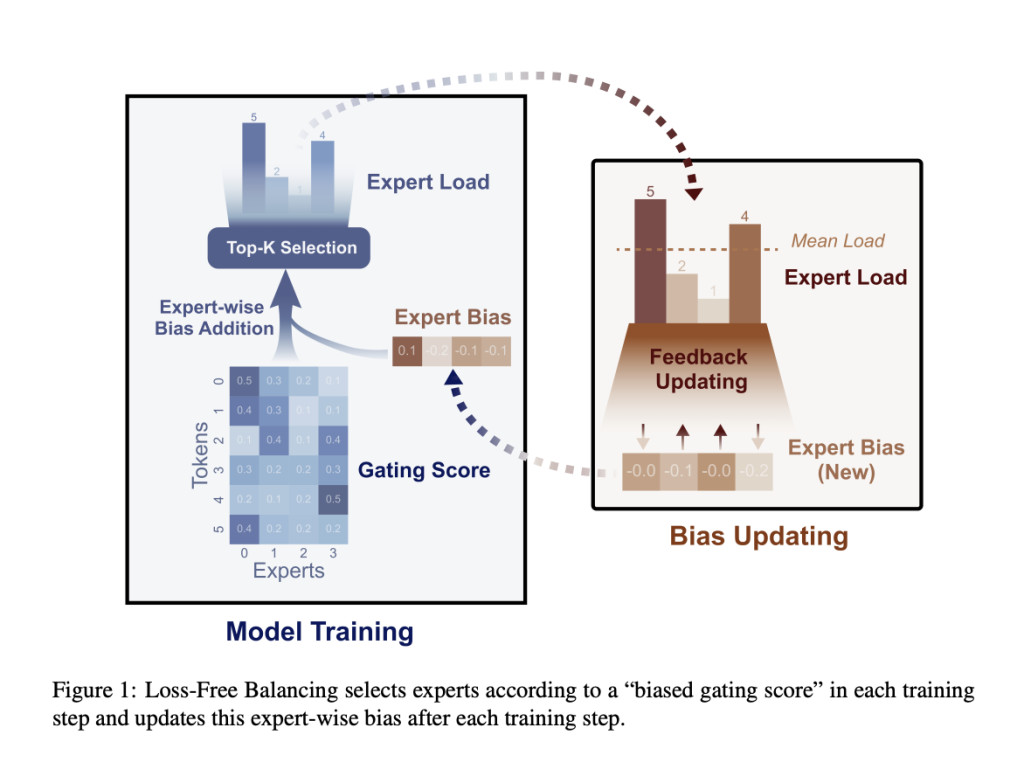Mixture-of-experts (MoE) models have emerged as a crucial innovation in machine learning, particularly in scaling large language models (LLMs). These models are designed to manage the growing computational demands of processing vast data. By leveraging multiple specialized experts within a single model, MoE architectures can efficiently route specific tasks to the most suitable expert, optimizing performance. This approach has proven beneficial in natural language processing (NLP), where simultaneously handling diverse and complex tasks is essential for achieving accuracy and efficiency.
One of the most significant challenges that MoE models face is load imbalance among experts. Some experts may become overloaded with tasks in such models, while others need to be more utilized, leading to inefficiencies. This imbalance can result in routing collapse, where the model repeatedly selects a few experts, thereby hindering the overall training process. Additionally, an uneven distribution of tasks increases computational overhead as the model needs help managing the workload effectively. Addressing this imbalance is critical, as it directly impacts the model’s ability to perform optimally, particularly when scaling up to handle large datasets and complex language processing tasks.
Traditional methods have employed auxiliary loss functions to mitigate the load imbalance problem. These functions penalize the model when there is an uneven distribution of tasks among the experts, thereby encouraging a more balanced load. While this approach can help achieve better balance, it also introduces new challenges. Specifically, the auxiliary loss introduces interference gradients during training, which conflict with the primary objective of the model—language modeling. These undesired gradients can impair the model’s performance, making it difficult to balance, maintain load balance, and achieve high levels of accuracy in language processing tasks. This trade-off has been a persistent issue in the development of MoE models.
DeepSeek-AI and Peking University researchers have developed a novel approach called Loss-Free Balancing. This method eliminates the need for auxiliary loss functions by dynamically adjusting the routing of tasks to experts based on their current load. Unlike previous methods, which introduced harmful gradients, Loss-Free Balancing focuses on maintaining a balanced distribution of tasks without interfering with the model’s primary training objectives. This approach allows the model to operate more efficiently, ensuring that all experts are utilized effectively without compromising performance.
The Loss-Free Balancing method operates through a dynamic process of expert-wise bias adjustment. Before making routing decisions, the model applies biases to the routing scores of each expert. These biases are continuously updated based on the recent load observed for each expert. For instance, if an expert has been heavily utilized in recent training steps, its bias is adjusted downward to reduce its load. Conversely, if an expert has been underutilized, its bias is increased, encouraging the model to route more tasks to it. This iterative process ensures the model maintains a consistent balance of functions across all experts, enhancing efficiency and performance.
Regarding empirical results, the Loss-Free Balancing method has significantly improved over traditional auxiliary loss-based strategies. In experiments conducted on MoE models with 1 billion (1B) parameters, trained on 100 billion (100B) tokens, and larger models with 3 billion (3B) parameters, trained on 200 billion (200B) tokens, the researchers observed notable enhancements in both load balance and overall model performance. For example, the validation perplexity, a key measure of model performance, was reduced to 9.50 in the 1B parameter model and 7.92 in the 3B parameter model when using Loss-Free Balancing. The method achieved a maximal violation (MaxVio) of global load balance as low as 0.04, significantly better than the results obtained with auxiliary loss-controlled methods. These findings underscore the effectiveness of the Loss-Free Balancing approach in maintaining a balanced load distribution while improving the model’s language processing capabilities.
The research team also explored various configurations and adjustments to further optimize the Loss-Free Balancing method. They experimented with different bias update rates and rules to determine the most effective approach. For instance, an update rate of 0.001 provided a good balance between convergence speed and load stability. While exploring alternative methods, such as multiplicative biases, the researchers concluded that additive biases offered superior performance and load balance. These refinements highlight the method’s adaptability and potential for further optimization in future applications.
In conclusion, the Loss-Free Balancing method enables more efficient and effective training of large-scale language models by addressing load imbalance without introducing interference gradients. The empirical results, including reduced validation perplexity and improved load balance metrics, demonstrate the potential of this approach to enhance the performance of MoE models across various applications.
Check out the Paper. All credit for this research goes to the researchers of this project. Also, don’t forget to follow us on Twitter and join our Telegram Channel and LinkedIn Group. If you like our work, you will love our newsletter..
Don’t Forget to join our 50k+ ML SubReddit
Here is a highly recommended webinar from our sponsor: ‘Building Performant AI Applications with NVIDIA NIMs and Haystack’
The post Loss-Free Balancing: A Novel Strategy for Achieving Optimal Load Distribution in Mixture-of-Experts Models with 1B-3B Parameters, Enhancing Performance Across 100B-200B Tokens appeared first on MarkTechPost.
Source: Read MoreÂ



